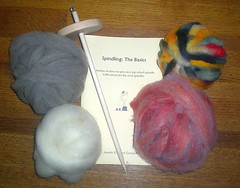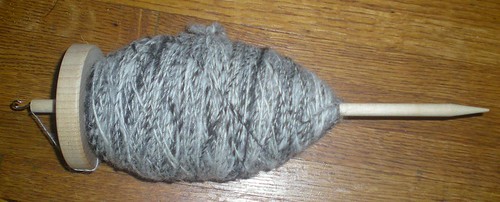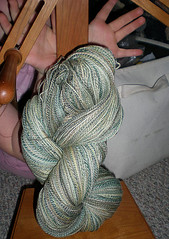This interview with "New Spindler" is brought to you from a collection of starting questions I've been accumulating. Enjoy!
NewSpindler: I’m very interested in spinning with a drop spindle. What do I need to get started, besides the spindle and roving?
TheBelle: Those are the two basic ingredients. There are many other things you could have, but those are all you have to have to get started. I usually recommend a 1.5-2 ounce spindle and some medium wool roving (Romney, Corriedale, or similar).
 The Bellwether's Learn To Spin Kit contains a great spindle, my little book, and a variety of nice wools to learn with. I've focused on keeping it excellent and affordable.
The Bellwether's Learn To Spin Kit contains a great spindle, my little book, and a variety of nice wools to learn with. I've focused on keeping it excellent and affordable.I love my niddy-noddy and my ball-winder. Although, you can use your arm as a niddy-noddy to make the skein, and wind balls with just your hands, so really no other tools are absolutely necessary beyond spindle and fiber.
A good book or video is always helpful, though there are plenty of on-line resources and nothing like the help of another spinner, if you have a local guild or yarn shop with one handy.
NewSpindler: After spinning one piece of roving, what do I do next. Do I wind that into a skein? Shouldn’t it be twisted with another section of roving to make a 2 ply yarn? What do I need for this?
 TheBelle: Once you've spun one piece of roving, if the spindle will fit more (it's not wobbling too badly, not too heavy, not slipping down), then join on another piece to spin a longer length. The V-join is a good one to learn.
TheBelle: Once you've spun one piece of roving, if the spindle will fit more (it's not wobbling too badly, not too heavy, not slipping down), then join on another piece to spin a longer length. The V-join is a good one to learn.The key is to have a staple length (individual fiber length) of fiber unspun on the old and the new pieces, so you can draft them together. The V shape helps make sure your overlap spins clean.

Once you have the spindle full, you can finish it as singles if you don't plan to ply, or you can make a 2-ply. For that, wind the spindle full into a tight ball, fill the spindle again, and wind the second spindlefull and the first into a 2-strand tight ball, to ply from. See this great plying article by Abby Franquemont.
NewSpindler: After I spin a bit, I take the yarn off the hook to wind it. It curls up something fierce, no matter how tightly it is spun. Is it overspun, or is this normal?
 TheBelle: The yarn curls up because there's twist in it. That's a "good thing". The trick is to fold a 4" length back on itself and let it curl naturally -- this shows you what your balanced 2-ply would look like. Do you like it? then you have a good amount of twist in there. Is it really poufy and has an open loop at the bottom? then you could add more twist. Is it really tight, so the twist on itself seems almost cork-screwy? then you might want to take some twist out. (Picture from Spindling: The Basics.)
TheBelle: The yarn curls up because there's twist in it. That's a "good thing". The trick is to fold a 4" length back on itself and let it curl naturally -- this shows you what your balanced 2-ply would look like. Do you like it? then you have a good amount of twist in there. Is it really poufy and has an open loop at the bottom? then you could add more twist. Is it really tight, so the twist on itself seems almost cork-screwy? then you might want to take some twist out. (Picture from Spindling: The Basics.)NewSpindler: If I spin worsted weight singles on a 1.75 oz Ashford spindle, does that mean I can't ply on the same spindle?
TheBelle: I spin worsted and spin or ply bulky on a 1.8 ounce spindle, which is close enough to say that your Ashford spindle should do just fine with plying. You'll also find that as you get more weight on the spindle, it may behave "better", since you're turning your 1.75 ounce spindle into a 1.8 ounce, 1.9 ounce, 2.0 ounce spindle as you add the yarn onto it.
NewSpindler: While I am spinning the fiber sometimes gets tangled on the yarn. I've heard of a wrist distaff, but can't figure out how it works. It seems I would need another hand to keep it all going.
TheBelle: My favorite wrist distaff is ... my wrist! I loosely wrap the roving around my wrist so it can unwrap itself via rotation as I need it. I'm also known to wear a roving "boa", or to just work with fairly short, 4"-8" lengths of roving. That way the roving doesn't get sweaty and I don't risk matting it if I'm spinning while I'm tense ... before the alpha rhythms of spinning kick in and I start relaxing ;)
NewSpindler: Finally, I'm confused as to the weight of a beginner's spindle. I have an Ashford, 1.75oz ... I assume it's a good beginner spindle. Recently at a spinning demo the demonstrator said a beginner should use a spindle that weighed less than an ounce. Obviously there are as many opinions as there are spindles, but any opinions with explanations as to why?
 TheBelle: I'm not sure why the teacher would say a spindle under an ounce is a good beginner spindle. I generally only recommend them to spindle spinners looking to spin finer yarns. Used to be, "beginner spindles" were 3 ounces or so -- but those also are problematic once you start drafting finer yarns. These days, most beginner kits have 1.4 - 2.0 ounce spindles in them.
TheBelle: I'm not sure why the teacher would say a spindle under an ounce is a good beginner spindle. I generally only recommend them to spindle spinners looking to spin finer yarns. Used to be, "beginner spindles" were 3 ounces or so -- but those also are problematic once you start drafting finer yarns. These days, most beginner kits have 1.4 - 2.0 ounce spindles in them.The basics of spindle weight is that the spindle weight is related to the thickness of yarn you spin -- lighter spindles for finer spinning, heavier for thicker. My dream team is a 0.5 ounce for laceweight, a 0.9-1.1 ounce for sockweight, and a 1.8 ounce for thick yarns and plying. If you have a spindle that's too light for your yarn, it stops spinning very quickly -- the twist in the yarn counteracts the light weight of the spindle and stops it. If you have a spindle that's too heavy for your yarn, it drags on the fiber as you draft and is likely to show you why it's called a "drop!" spindle.
NewSpindler: I'm allergic to wool. What can I learn to spin with?
The Belle: It's possible to learn without wool, just a little harder. How far does your wool allergy extend? My second choice would be llama or alpaca, third choice perhaps hemp. KnittySpin has some articles a few issues back; Amy Singer, their chief, learned to spin with hemp, as animal fibers send her allergies sky rocketting.
In Closing ...
Spindling is fun -- when you are learning, be sure to take breaks. Your hands need time to get the information to your brain, and your brain to process it, so you can make the actions more automatic. 10 minutes at a time, maybe 4 times a day (if you can), and in a few weeks (or sooner, or maybe a few months like me) you'll be spindling away in short order.
 Don't have spindle and fiber yet? Let me recommend The Bellwether's Learn To Spin Kit. It has a terrific spindle, a variety of fibers, and Spindling: The Basics. Even Abby likes it (thanks, Abby! that means alot!)
Don't have spindle and fiber yet? Let me recommend The Bellwether's Learn To Spin Kit. It has a terrific spindle, a variety of fibers, and Spindling: The Basics. Even Abby likes it (thanks, Abby! that means alot!)Happy spindling!
- Amelia aka The Belle
~~
Related Posts:
Why learn to spin with Romney and not BFL?
How can I spin on a budget?
Do you set the twist in singles before you ply?
How does a beginning spinner control overspin?
Which spindle spins the best?
After wheel or spindle, what's your most useful tool?
A Spindler's Bibliography
~~
 A year ago today ... I was posting about spinning sock yarn. I've done 3 sock skeins for myself since then, but have yet to knit them. However, I've just fired up the sock machine and wound two of them onto bobbins, so perhaps there will be socks soon! The most exciting was the spindled skein, which remains "in skein" for me to continue admiring a while yet. It's just too fabulous :) it's not ready to grow up and be socks just yet. The one in the picture here was wheel spun and eminently sockable now!
A year ago today ... I was posting about spinning sock yarn. I've done 3 sock skeins for myself since then, but have yet to knit them. However, I've just fired up the sock machine and wound two of them onto bobbins, so perhaps there will be socks soon! The most exciting was the spindled skein, which remains "in skein" for me to continue admiring a while yet. It's just too fabulous :) it's not ready to grow up and be socks just yet. The one in the picture here was wheel spun and eminently sockable now!~~
posted 9 January 2009 at http://askthebellwether.blogspot.com/
